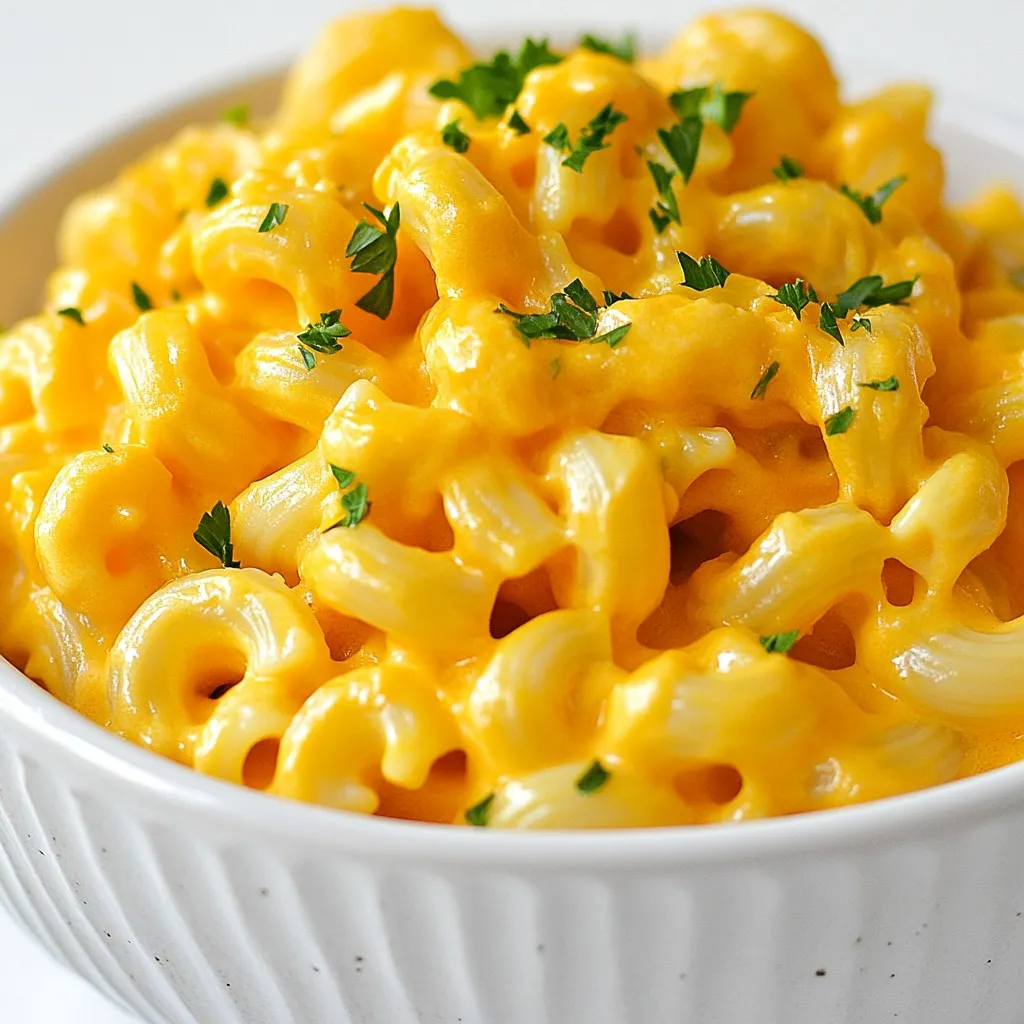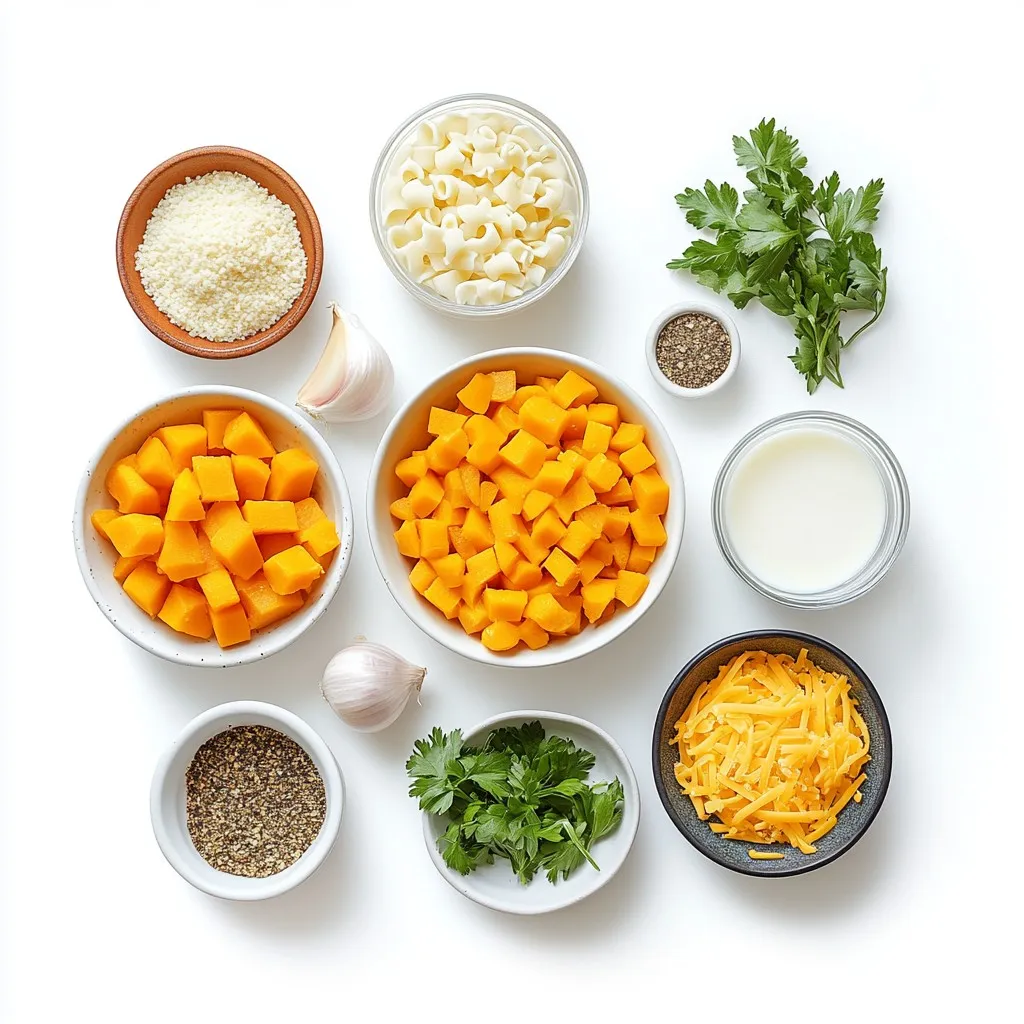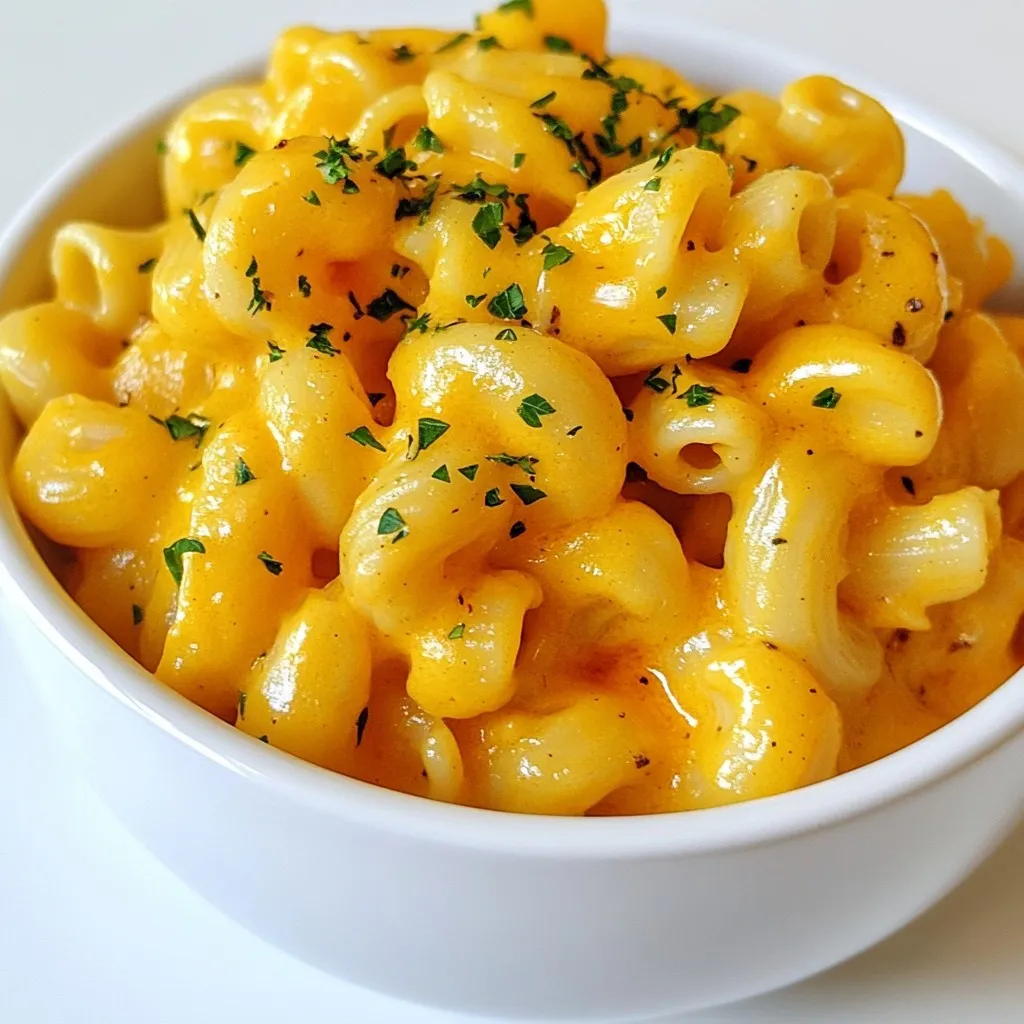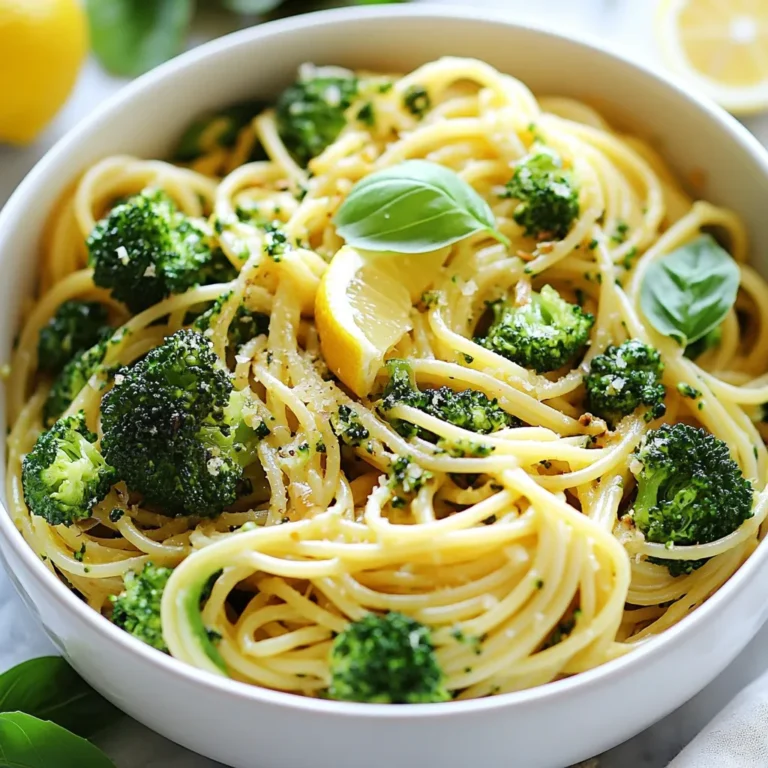Butternut Squash Mac and Cheese Creamy Comfort Food

Get ready for a cozy meal with my Butternut Squash Mac and Cheese! This creamy comfort food pairs the sweetness of butternut squash with sharp cheese for a dish that’s rich and satisfying. Whether you’re a cheese lover or just looking for a tasty way to add veggies, this recipe is perfect for you. Join me in exploring how to create this warm, delicious meal step by step!
Why I Love This Recipe
- Comfort Food at its Best: This creamy butternut squash mac and cheese is the ultimate comfort food, combining the nostalgic flavors of mac and cheese with a healthy twist.
- Rich in Flavor: The addition of roasted butternut squash not only gives this dish a vibrant color but also adds a natural sweetness that beautifully complements the sharp cheddar cheese.
- Customizable: You can easily modify this recipe by using different types of cheese or even adding in your favorite vegetables for a personalized touch.
- Perfect for Any Occasion: Whether it’s a cozy family dinner or a festive gathering, this creamy mac and cheese is sure to impress and satisfy everyone at the table.
Ingredients
Main Ingredients
- 8 ounces elbow macaroni
- 2 cups butternut squash, peeled and diced
- 2 tablespoons olive oil (divided)
- 1 medium onion, finely chopped
- 2 cloves garlic, minced
Dairy and Broth
- 1 ½ cups vegetable broth
- 1 cup milk (or plant-based milk)
- 1 ½ cups shredded sharp cheddar cheese
- ½ cup grated Parmesan cheese
Seasonings
- 1 teaspoon ground nutmeg
- 1 teaspoon smoked paprika
- Salt and freshly ground pepper, to taste
- Fresh parsley, chopped (for garnish)
Butternut squash mac and cheese is a dish that warms the heart. The main ingredients create a rich base. Elbow macaroni gives a cozy texture. Butternut squash adds a sweet, creamy element. Olive oil helps sauté the onions and garlic, giving a fragrant touch.
In the dairy and broth section, the vegetable broth and milk bring creaminess. Sharp cheddar cheese adds a bold flavor. Parmesan cheese melts perfectly, making the dish extra cheesy.
For seasonings, ground nutmeg enhances the sweetness of the squash. Smoked paprika adds depth and warmth. A pinch of salt and pepper is essential to balance the flavors. Lastly, fresh parsley provides a bright finish to each bowl.
Gather these ingredients, and get ready to create a creamy comfort food that will leave everyone smiling!

Step-by-Step Instructions
Cooking the Pasta
To start, grab a large pot. Fill it with water and add a pinch of salt. This helps season the pasta. Turn the heat on high and bring the water to a rolling boil. Once boiling, add the elbow macaroni. Cook according to the package directions, about 7 to 9 minutes. You want it al dente, firm to the bite. When done, drain the pasta in a colander. Set it aside while you prepare the rest.
Roasting the Butternut Squash
Next, we will roast the butternut squash. Preheat your oven to 400°F (200°C). While it heats, take a large baking sheet. Toss the diced butternut squash with 1 tablespoon of olive oil. Season with salt and pepper for flavor. Spread the squash evenly on the baking sheet. Roast it for 20 to 25 minutes. Stir halfway through so it cooks evenly. The squash should be tender and slightly caramelized.
Sautéing Aromatics and Making the Sauce
Now, let’s get aromatic! In a large skillet, heat the remaining tablespoon of olive oil over medium heat. Add the finely chopped onion and sauté until it’s soft and clear, about 5 minutes. Then, add the minced garlic and cook for 1 more minute. The smell will be amazing! Once the squash is done roasting, add it to the skillet. Then, pour in the vegetable broth and milk. Sprinkle in the ground nutmeg and smoked paprika. Stir everything together and let it simmer gently. Use an immersion blender to puree the mix until it’s smooth and creamy.
Combining Cheeses and Mixing with Pasta
It’s cheese time! Stir in the shredded sharp cheddar and grated Parmesan into the creamy sauce. Mix well until the cheese melts. This makes the sauce extra rich. Taste it and adjust with salt and freshly ground pepper as needed. Add the drained macaroni to the cheese sauce. Gently stir to coat every piece. You want each elbow to be covered in that creamy goodness.
Optional Baking Instructions
If you want a baked version, this step is for you. Transfer the mac and cheese to a greased baking dish. For an extra cheesy crust, sprinkle some more cheddar on top. Bake in the preheated oven at 350°F (175°C) for 15 to 20 minutes. You want it bubbly and golden on top.
Garnishing and Serving
Once baked, remove the dish from the oven. Let it cool for a few minutes. This helps the sauce set a bit. Before serving, garnish each portion with fresh chopped parsley. This adds a nice pop of color and flavor. Enjoy your creamy butternut squash mac and cheese!
Tips & Tricks
Achieving Creamy Consistency
To make your butternut squash mac and cheese creamy, blending is key. Once you roast the squash, use an immersion blender to puree it. This step makes the sauce smooth and rich. If you don’t have one, transfer the squash mix to a regular blender. Blend it until creamy and return it to the skillet. Adjust moisture levels by adding more milk or broth if needed. This keeps your sauce from being too thick or too watery.
Enhancing Flavor Profiles
To enhance the flavors, seasonings are your best friend. I love using ground nutmeg and smoked paprika. Nutmeg adds warmth, while smoked paprika gives a nice depth. Feel free to experiment with other spices, too. A pinch of cayenne or red pepper flakes adds a bit of spice. Just remember to add these gradually. Taste your sauce as you go to find the perfect balance.
Alternatives for Dietary Preferences
If you want a vegan dish, swap the cheese with nut-based options. Nutritional yeast gives a cheesy flavor without dairy. For the milk, use almond, soy, or oat milk. For gluten-free options, choose gluten-free elbow macaroni. You can also look for gluten-free cheese brands. These swaps make the dish friendly for different diets while keeping it tasty.
Pro Tips
- Choose the Right Cheese: For a creamier texture, opt for a combination of cheeses. Mixing sharp cheddar with a milder cheese like Gruyère can add depth and richness to your mac and cheese.
- Perfectly Roasted Squash: Ensure your butternut squash is cut into uniform pieces to promote even roasting. This will enhance the sweetness and flavor in your dish.
- Enhance Flavor with Spices: Don’t hesitate to experiment with spices! Try adding a pinch of cayenne pepper for a little heat or a sprinkle of Italian herbs to elevate the flavor profile.
- Make Ahead: This dish can be made ahead of time and stored in the refrigerator. Just reheat it in the oven for a comforting, quick meal later!

Variations
Vegan Butternut Squash Mac and Cheese
To make this dish vegan, swap out dairy products. Use plant-based milk, like almond or oat milk. For cheese, try vegan cheese shreds. These melt well and add creamy texture. Nutritional yeast is a great choice too. It gives a cheesy flavor without dairy. You can also blend in some soaked cashews for added creaminess. Just remember to keep an eye on the salt. Sometimes, vegan cheese can be saltier.
Gluten-Free Options
For gluten-free mac and cheese, choose alternative pasta types. Brown rice or chickpea pasta works well. They have a nice texture and taste. Make sure to cook them al dente. This keeps them from getting mushy in the sauce. For cheese, look for gluten-free cheese brands. Many have great flavor and melt nicely. Always check the labels to ensure they’re gluten-free.
Adding Extra Vegetables
Boost nutrition by adding extra veggies. Spinach, kale, or broccoli are excellent choices. They add color and flavor. To incorporate greens, sauté them with the onions. This softens them and enhances their taste. You can also stir in cooked peas or roasted bell peppers. This adds a fun twist and makes it more filling. Don’t be afraid to get creative with your veggie choices!
Storage Info
Refrigeration
To store leftovers, let the butternut squash mac and cheese cool completely. Place it in an airtight container. This will keep it fresh and tasty. Use glass or BPA-free plastic containers for best results.
Freezing Instructions
For freezing, scoop the cooled mac and cheese into freezer-safe bags or containers. Press out as much air as possible before sealing. This prevents freezer burn. When ready to use, thaw it in the fridge overnight. Reheat in a pot over low heat or in the microwave until warm.
Shelf Life
You can store the refrigerated mac and cheese for up to 4 days. In the freezer, it lasts about 3 months. Look for signs of spoilage, such as a sour smell or mold. If it looks or smells off, toss it out. Always prioritize food safety!
FAQs
What can I substitute for butternut squash?
You can use sweet potatoes, pumpkin, or acorn squash. Each option adds a sweet, earthy flavor. Sweet potatoes create a similar creamy texture. Pumpkin adds a brighter color and mild taste. Acorn squash has a nutty flavor, making it a great choice too.
Can I make this recipe ahead of time?
Yes, you can prep it ahead. Cook the pasta and squash, then store them in the fridge. Make the cheese sauce and mix it in before baking. This way, you save time on busy days. Just remember to heat it up before serving.
Is butternut squash mac and cheese healthy?
Yes, butternut squash is rich in vitamins A and C. It also has fiber, which aids digestion. Using less cheese makes it lighter. You can also swap milk for plant-based options to boost nutrients. This dish is comfort food that can be good for you!
How to make it spicier?
Add crushed red pepper flakes for heat. You can also mix in diced jalapeños or hot sauce. Smoked paprika has a bit of warmth too. Adjust the spice to fit your taste. It brings a fun twist to this creamy dish!
Can I use other types of cheese?
Absolutely! Try gouda or Monterey Jack for a twist. Cream cheese can make it extra creamy. If you like a stronger taste, go for blue cheese. Mix and match to find your favorite blend. Each cheese adds a unique flavor to your mac and cheese!
You now have a clear guide to making a delicious butternut squash mac and cheese. We covered the key ingredients, step-by-step instructions, and helpful tips for perfection. Don’t forget the variations for different diets and preferences. Remember, you can easily adjust flavors and try new veggies. This dish is comforting and packed with nutrients. Enjoy your cooking, and let it bring warmth to your table! Now go create your creamy masterpiec

Creamy Butternut Squash Mac & Cheese
Ingredients
- 8 ounces elbow macaroni
- 2 cups butternut squash, peeled and diced
- 2 tablespoons olive oil
- 1 medium onion, finely chopped
- 2 cloves garlic, minced
- 1.5 cups vegetable broth
- 1 cup milk (or your favorite plant-based milk)
- 1 teaspoon ground nutmeg
- 1 teaspoon smoked paprika
- 1.5 cups shredded sharp cheddar cheese
- 0.5 cup grated Parmesan cheese
- to taste salt and freshly ground pepper
- for garnish fresh parsley, chopped
Instructions
- In a large pot, fill with water and add a generous pinch of salt. Bring the water to a rolling boil. Add the elbow macaroni and cook according to the package instructions until al dente, usually about 7-9 minutes. Once cooked, drain and set aside.
- Preheat your oven to 400°F (200°C). On a large baking sheet, toss the peeled and diced butternut squash with 1 tablespoon of olive oil, and season with salt and pepper. Spread it out evenly and roast for 20-25 minutes, or until it is tender and lightly caramelized, stirring halfway through for even browning.
- In a large skillet, heat the remaining tablespoon of olive oil over medium heat. Add the finely chopped onion and sauté until it becomes soft and translucent, about 5 minutes. Then, add the minced garlic and cook for an additional minute, until fragrant.
- Once the butternut squash is roasted, transfer it to the skillet with the sautéed onions and garlic. Add the vegetable broth and milk, then sprinkle in the ground nutmeg and smoked paprika. Stir everything together and bring the mixture to a gentle simmer. Use an immersion blender to puree the mixture until it is smooth and creamy. If you don't have an immersion blender, carefully transfer the mixture to a regular blender and blend until smooth, then return it to the skillet.
- Stir in the shredded sharp cheddar cheese and grated Parmesan cheese into the creamy sauce, mixing well until all the cheese has melted and the sauce is beautifully combined. Taste, and season with salt and freshly ground pepper to your preference.
- Add the drained macaroni to the cheese sauce, gently stirring to ensure that every piece of elbow macaroni is generously coated with the creamy sauce.
- For a baked version, transfer the mac and cheese to a greased baking dish. Sprinkle some extra cheddar on top for a cheesy crust. Bake in the preheated oven at 350°F (175°C) for 15-20 minutes, or until bubbly and golden on top.
- Once ready, remove from the oven and let it cool slightly. Garnish each serving with a sprinkle of fresh chopped parsley for a pop of color before serving.


![To make this tasty dish, gather these simple ingredients: - 1 pound Brussels sprouts, trimmed and halved - 3 tablespoons extra virgin olive oil - 1/4 cup pure maple syrup - 2 tablespoons balsamic vinegar - 1 teaspoon Dijon mustard - 1/2 teaspoon fine sea salt - 1/4 teaspoon freshly ground black pepper - 1/4 cup pecans, roughly chopped for added crunch - 1/4 cup dried cranberries for a touch of sweetness - Fresh thyme leaves for an aromatic garnish (optional) You can easily adjust ingredient amounts based on what you need. Here are some quick conversions: - If you want to make more, use 2 pounds of sprouts and double the glaze. - For less, cut the amounts in half. This still keeps the taste great. - In a pinch, you can swap the pecans for walnuts or almonds. This dish not only tastes good but is also good for you. Here’s a quick look at what’s inside: - Calories: About 200 per serving - Fat: 12 grams (mostly healthy fats from olive oil and nuts) - Carbohydrates: 24 grams (includes natural sugars from maple syrup) - Fiber: 5 grams (great for digestion from Brussels sprouts) - Protein: 3 grams (from nuts and sprouts) This breakdown helps you see the benefits of each ingredient. Enjoy making this dish with fresh, seasonal produce for the best flavor and health benefits. For the complete recipe, check out the Full Recipe. Start by preheating your oven to 400°F (200°C). This step is key for getting perfect crispness. While the oven warms up, clear your kitchen counter. Gather all your tools and ingredients. Having everything ready makes cooking much easier. Take 1 pound of Brussels sprouts. Trim off the ends and cut them in half. Place the halved sprouts in a large mixing bowl. Add 3 tablespoons of extra virgin olive oil and 1/2 teaspoon of fine sea salt. Sprinkle in 1/4 teaspoon of freshly ground black pepper. Toss the sprouts until they are well coated. This ensures each sprout gets flavor. Spread the seasoned Brussels sprouts on a baking sheet. Make sure the cut sides face down. This helps them brown nicely. Place the baking sheet in your preheated oven. Roast for 20-25 minutes. They should be crispy and golden. While they roast, make the maple glaze. In a small saucepan, mix 1/4 cup of pure maple syrup, 2 tablespoons of balsamic vinegar, and 1 teaspoon of Dijon mustard. Heat over medium heat but do not let it boil. Once the sprouts are ready, drizzle the glaze over them. Toss gently to coat. Return the glazed sprouts to the oven for 5 more minutes. This step caramelizes the glaze, making it rich and tasty. After that, take them out and add 1/4 cup of roughly chopped pecans and 1/4 cup of dried cranberries. These add crunch and sweetness. If you want, garnish with fresh thyme leaves for even more flavor. For the full details, check the Full Recipe. When you pick Brussels sprouts, look for bright green ones. They should feel firm and heavy in your hand. Avoid any that have yellow leaves or feel soft. The size matters too; smaller sprouts are sweeter and more tender. If you can, buy them on the stalk. They stay fresh longer that way. Caramelization makes Brussels sprouts sweet and tasty. To get it right, roast them cut-side down. This lets them get nice and brown. Make sure they have space on the baking sheet. If they are too close together, they will steam instead of roast. Use high heat, about 400°F, for best results. Check them halfway through and give them a stir for even cooking. One big mistake is overcooking the sprouts. They should be tender but still have a bit of crunch. Avoid using too much glaze; it can make them soggy. Always glaze right after roasting, then caramelize them for just a few minutes. This step adds flavor without losing the sprout's crispness. Lastly, don’t skip the nuts and cranberries; they add great texture and taste. For the full recipe, check the [Full Recipe]. {{image_4}} You can change the taste of maple glazed Brussels sprouts by adding different nuts or seeds. Try walnuts for a rich flavor or sunflower seeds for a crunch. Almonds also work well; they add a nice texture and nutty taste. Each option gives a new twist to your dish. Just sprinkle them on top after roasting for the best crunch and flavor. If you need to adjust for dietary needs, it’s easy. Use agave syrup instead of maple syrup for a vegan option. For a nut-free dish, skip the pecans and use pumpkin seeds. You can also swap balsamic vinegar with apple cider vinegar for a light zing. These swaps keep the dish tasty while meeting your needs. Brussels sprouts shine in fall and winter, but you can adapt them year-round. In spring, add fresh herbs like basil or parsley for brightness. In summer, pair with grilled corn for a sweet twist. You can also mix in seasonal veggies like carrots or sweet potatoes for color and taste. This way, your dish stays fresh and exciting no matter the season. For the full recipe, check out the Maple Glazed Brussels Sprouts Delight. After enjoying your maple glazed Brussels sprouts, store leftovers right. Place them in an airtight container. They will stay fresh for about three days in the fridge. Keep them away from strong-smelling foods. This helps maintain their flavor. When you reheat, aim to keep the sprouts crispy. Use your oven for the best results. Preheat it to 350°F (175°C). Spread the sprouts on a baking sheet. Heat them for about 10-15 minutes. This method helps keep them crunchy and flavorful. You can also microwave them for quick reheating, but they may not stay as crispy. If you want to enjoy these sprouts later, freezing works too. First, let them cool completely. Spread them on a baking sheet in a single layer. Freeze until solid, then transfer to a zip-top bag. They can last up to three months in the freezer. When ready to eat, thaw them overnight in the fridge. Reheat using the oven for the best taste. Enjoy your tasty treat again! Yes, you can prepare these Brussels sprouts ahead of time. After roasting them, let them cool. Store them in an airtight container in the fridge. They stay fresh for up to three days. When you're ready to serve, just reheat them in the oven. This keeps them crispy and tasty. These Brussels sprouts pair well with many dishes. Serve them alongside roasted chicken or grilled salmon for a complete meal. They also shine as a side dish for holiday dinners. You can even enjoy them with a grain salad or pasta for a light lunch. The sweet glaze adds a nice touch to any plate. You can easily change the sweetness of the glaze. If you want it sweeter, add more maple syrup. Start with an extra tablespoon and taste as you go. For a less sweet glaze, reduce the maple syrup. You can add more balsamic vinegar to balance the flavor. Adjust it to match your taste! We explored how to make Maple Glazed Brussels Sprouts from start to finish. You learned about ingredients, cooking steps, and storage tips. I shared helpful tricks to avoid mistakes and ensure a tasty outcome. You can now customize your dish with variations and serve it with confidence. Remember, fresh ingredients and careful roasting lead to the best flavors. Enjoy making this dish and impress your family and friends. With practice, your skills will grow. Happy cooking!](https://dishtreats.com/wp-content/uploads/2025/07/6c550e47-e99c-4554-a6d4-422f3e5f831a-768x768.webp)

![- 1 cup quinoa - 2 cups water or vegetable broth - 1 large cucumber, diced - 1 red bell pepper, diced - 1 cup cherry tomatoes, halved - 1/4 red onion, finely chopped - 1 cup fresh parsley, roughly chopped - 1/4 cup tahini - 2 tablespoons fresh lemon juice - 1 tablespoon extra virgin olive oil - 1 clove garlic, minced - Salt and freshly cracked pepper - 1/4 cup sunflower seeds - Chopped nuts (walnuts or almonds) The ingredients for your Lemon Tahini Quinoa Salad are fresh and colorful. Each one adds flavor and nutrition. Start with quinoa, which is the base of this dish. It is high in protein and gluten-free. For the salad, you need diced cucumber, red bell pepper, cherry tomatoes, red onion, and parsley. The cucumber gives crunch. The red bell pepper adds sweetness. Cherry tomatoes bring juiciness. The red onion gives a mild bite, while parsley adds a fresh taste. Next, let’s talk about the dressing. Tahini is a creamy paste made from sesame seeds. It gives richness to the salad. Lemon juice adds zing and brightness. Olive oil makes it smooth. Garlic adds depth of flavor. A pinch of salt and cracked pepper finishes it off. If you want more texture, try adding sunflower seeds or chopped nuts. They add crunch and healthy fats. This Lemon Tahini Quinoa Salad is easy to make and packed with good ingredients. You can find the Full Recipe to guide you through the steps. First, you need to cook the quinoa. Combine one cup of rinsed quinoa and two cups of water or vegetable broth in a medium saucepan. Bring the mixture to a rapid boil over medium-high heat. Once it boils, lower the heat and cover the pot. Let it simmer for about 15 minutes. The quinoa will soak up all the liquid and become fluffy. After cooking, remove it from heat and let it cool for a bit. While the quinoa cooks, you can prepare the dressing. In a small bowl, whisk together a quarter cup of tahini, two tablespoons of fresh lemon juice, one tablespoon of olive oil, and one clove of minced garlic. Mix until it becomes smooth and creamy. You can add salt and pepper to taste. Now it's time to make the salad. In a large mixing bowl, add one large diced cucumber, one diced red bell pepper, one cup of halved cherry tomatoes, one-fourth of a finely chopped red onion, and one cup of roughly chopped fresh parsley. Stir these ingredients together until they are well mixed. Next, add the cooled quinoa to the bowl with the veggies. Toss everything together gently so the ingredients blend well. Drizzle the tahini dressing over the salad and mix again. For a nice crunch, you can sprinkle a quarter cup of sunflower seeds or chopped nuts on top before serving. For the full recipe, refer to the earlier sections. Enjoy your fresh and flavorful Lemon Tahini Quinoa Salad! To make the best quinoa, start with rinsing it well. This removes any bitter coating. Use cold water and a fine mesh strainer. After rinsing, cook the quinoa in water or broth. Cooking this way adds a nice flavor. Once cooked, let it cool a bit. This helps it mix better with other ingredients. For a creamy dressing, whisk all ingredients together. Use a bowl that allows for easy mixing. If you find clumps, keep whisking until smooth. Adjust the lemon juice and tahini to match your taste. You may like it tangy or mild. Experiment to find your favorite balance. Presentation is key! Serve the salad in colorful bowls. This makes it more inviting and fun. Add lemon slices and fresh parsley on top for a pop of color. These garnishes not only look great but also add extra flavor. For a unique touch, use clear glasses to showcase the vibrant layers of the salad. Check the Full Recipe for more tips on serving! {{image_4}} You can easily boost the protein in your Lemon Tahini Quinoa Salad. Incorporate chickpeas for a hearty touch. These legumes add fiber and flavor. Diced grilled chicken also works well if you want meat. For those following a vegan diet, try tempeh or tofu. Both options soak up flavors and make the salad filling. Feel free to mix in various vegetables. Substitute or add bell peppers, carrots, or creamy avocado. These veggies add crunch and color. You can also use seasonal vegetables for extra freshness. Think of bright summer tomatoes or hearty winter squash. The key is to choose what you enjoy most. Spice up your salad with fun flavors. Add spices like cumin or paprika for a tasty twist. These spices bring warmth and depth to the dish. Fresh herbs like mint or cilantro can brighten things up, too. They add a burst of freshness that takes your salad to the next level. Store your Lemon Tahini Quinoa Salad in an airtight container in the fridge. This keeps it fresh and tasty. It’s best to eat it within 3-5 days. After this time, the flavors may fade, and veggies can lose their crunch. You can freeze quinoa salad if needed. Dress it before serving after you thaw it. Be aware that freezing may change the texture of some vegetables. It’s a good idea to use firmer veggies like bell peppers, as softer ones may not hold up well. I don’t recommend reheating salads. They taste best when served chilled. However, if you want to reheat, you can warm individual components like quinoa or cooked veggies. Just make sure to let them cool before mixing back into the salad. Enjoy the fresh, vibrant flavors! Yes, it's great for meal prep; just dress before serving. This salad stays fresh for days. You can cook the quinoa and chop the veggies in advance. When you are ready to eat, mix in the dressing. This way, the salad will taste fresh. Yes, quinoa is naturally gluten-free. It makes this salad a perfect choice for gluten-free diets. Always check that your other ingredients, like broth, are gluten-free too. This salad is friendly for many diets. You can add different vegetables, proteins, or dressings to suit your taste. Try adding chickpeas for protein or avocados for creaminess. You can also change the herbs or use a different dressing. The choices are endless! It can be a side dish or a main dish, served chilled or at room temperature. For a picnic, serve it cold. If you want a warm meal, let it sit for a bit. Dress it just before serving for the best flavor. Yes, other grains like farro or bulgur can be used as substitutes. Each grain brings a different taste and texture. You can experiment to find your favorite. Just cook them according to package directions. Check the [Full Recipe] for more details! This blog post covered how to make a tasty Lemon Tahini Quinoa Salad. You learned the main ingredients, cooking steps, and tips for perfecting the dish. Remember, feel free to add your favorite proteins or veggies. You can also make it ahead of time for meal prep. Enjoy this salad fresh and chilled for the best flavor. Experiment with it, and you'll find your perfect mix!](https://dishtreats.com/wp-content/uploads/2025/07/0131a3b2-a937-48f9-ad75-9f78e7be101a-768x768.webp)

![- 4 bone-in, skin-on chicken thighs - 1/4 cup honey - 4 cloves garlic, finely minced - 2 tablespoons soy sauce - 1 tablespoon apple cider vinegar - 1 tablespoon extra virgin olive oil - 1 teaspoon freshly grated ginger - 1/2 teaspoon ground black pepper - Salt, to taste - Chopped green onions and toasted sesame seeds For this recipe, I focus on fresh ingredients. The chicken thighs give a rich flavor. Honey and garlic bring sweetness and zest. Soy sauce adds depth, while apple cider vinegar provides a nice tang. Extra virgin olive oil keeps everything moist and tasty. I love the hint of ginger in this dish. It adds a warm note that enhances the glaze. The black pepper gives a slight kick, balancing the sweetness. For the finishing touch, green onions and sesame seeds add color and crunch. These ingredients work together to create a delightful meal. You can find the full recipe for Honey Garlic Glazed Chicken Thighs at the end of this article. Enjoy cooking! In a medium bowl, whisk together the honey, minced garlic, soy sauce, apple cider vinegar, olive oil, grated ginger, black pepper, and a pinch of salt. Make sure the mixture is smooth and well-blended. This marinade is the key to great flavor. Next, place the chicken thighs in a large zip-lock bag or a shallow dish. Pour the marinade over the chicken. Ensure each piece is well coated. Seal the bag or cover the dish tightly. Refrigerate for at least 1 hour, though overnight is best for deep flavor. Preheat your oven to 400°F (200°C). This heat ensures a crispy skin. Remove the chicken from the marinade, saving some for later. Place the chicken skin-side up on a baking tray lined with parchment paper. Bake for 30-35 minutes. The chicken is ready when its internal temperature hits 165°F (74°C) and the skin is golden and crispy. To get that perfect crispy skin, you need to start with dry chicken. Pat the chicken thighs dry with paper towels. This helps remove excess moisture. Also, make sure your oven is hot before baking. Preheat it to 400°F (200°C). Place the chicken skin-side up on a lined baking tray. This position allows the skin to crisp up nicely. Finally, don't cover the chicken while it bakes. This keeps the skin exposed to the heat for better crispiness. Marinating time is key for flavor. I recommend at least one hour for good taste. If you have time, let the chicken marinate overnight. This allows the flavors to soak in deeply. Use a zip-lock bag for easy marinating. Just remember to seal it well, so the marinade doesn’t leak. A longer marinating time helps tenderize the meat, making it juicy and flavorful. For the glaze, you want a syrupy texture. After baking, take the leftover marinade and heat it in a saucepan. Simmer it over medium heat for about 5-7 minutes. Stir it occasionally to prevent sticking. The goal is to reduce the liquid until it thickens. This will create a lovely glaze that clings to the chicken. If it’s too thick, add a splash of water to loosen it. {{image_4}} You can easily boost flavor with fresh herbs. Use rosemary, thyme, or parsley. Chop them finely and mix them into the marinade. This adds a vibrant taste that pairs well with the honey and garlic. Fresh herbs also add a nice pop of color to your dish. Just remember to adjust the amount based on your taste. For a kick, add red pepper flakes into your marinade. Start with a pinch and taste as you go. This small change can take your dish from sweet to spicy. The heat balances well with the honey's sweetness. Serve with a side of cooling yogurt or sour cream to tame the spice. It creates a fun contrast. Grilling gives this dish a smoky flavor that is hard to beat. Before grilling, marinate the chicken as usual. Preheat your grill to medium heat. Cook the thighs skin-side down for the first few minutes. Flip them for an even char. Use the reserved marinade to baste while grilling. This method ensures a tasty glaze that sticks to the chicken. Enjoy the delicious, crispy skin with that smoky flavor! For the complete recipe, check the [Full Recipe]. To keep your honey garlic glazed chicken thighs fresh, store them promptly. Place the cooled chicken in an airtight container. This will help keep the flavors intact. Be sure to eat the leftovers within three to four days for the best taste and safety. To freeze your chicken thighs, first let them cool completely. Wrap each thigh tightly in plastic wrap, then place them in a freezer-safe bag. This method helps avoid freezer burn. You can keep them frozen for up to three months. When ready to eat, thaw the chicken in the fridge overnight for best results. To reheat chicken thighs, use the oven to keep them juicy. Preheat your oven to 350°F (175°C). Place the chicken on a baking sheet and cover it with foil. This will trap steam and keep the meat moist. Heat for about 15 to 20 minutes, or until the chicken is warm. Enjoy the great taste all over again! For more details, check the Full Recipe. For the best flavor, you should marinate chicken thighs for at least 1 hour. But if you can, marinate them overnight. This allows the flavors to soak deep into the meat. A longer marination time helps the chicken become tender and full of taste. Yes, you can use other cuts of chicken. Chicken breasts work well, but they may dry out faster. If you prefer, you can also use bone-in chicken legs. These alternatives will still absorb the honey garlic flavor, making your dish just as tasty. You can pair this dish with many sides. Here are some great options: - Steamed rice or jasmine rice - Roasted vegetables, like broccoli or carrots - A fresh garden salad with a light vinaigrette - Mashed potatoes for a creamy side - Quinoa for a healthy grain option These sides will complement the savory taste of the chicken and make your meal more satisfying. For the full recipe, check out the [Full Recipe] section. This blog post covered how to make delicious Honey Garlic Glazed Chicken Thighs. You learned about the key ingredients, step-by-step cooking methods, and helpful tips for the best results. We also explored tasty variations and safe storage advice. Enjoying this dish can add flavor to your meals. Whether you choose to grill it or try a spicy twist, these chicken thighs will impress. Keep experimenting, and make this recipe your own!](https://dishtreats.com/wp-content/uploads/2025/07/b9cba3e0-ee7f-4dbf-9eac-9b8411a1c4fd-768x768.webp)
